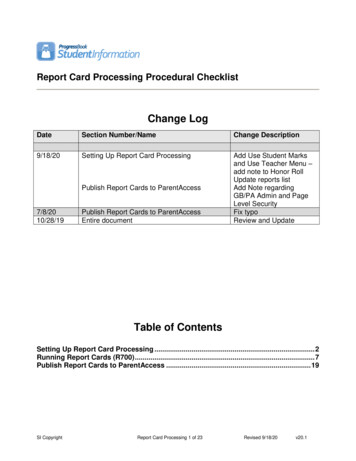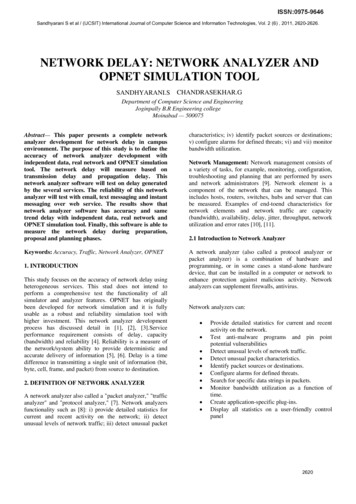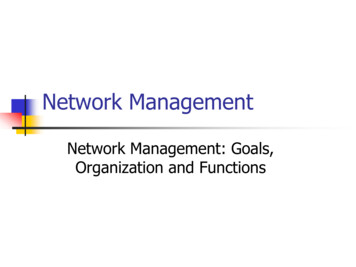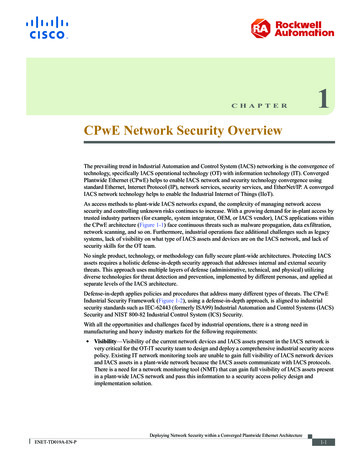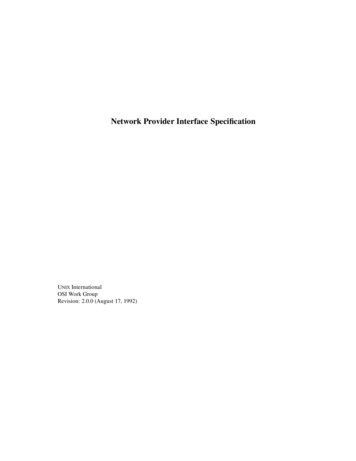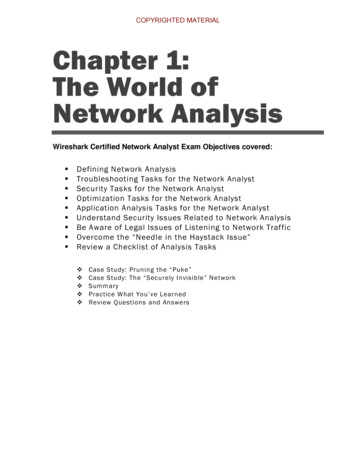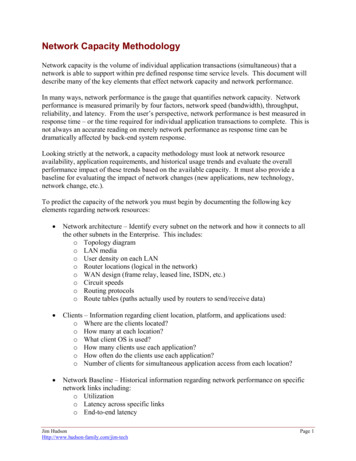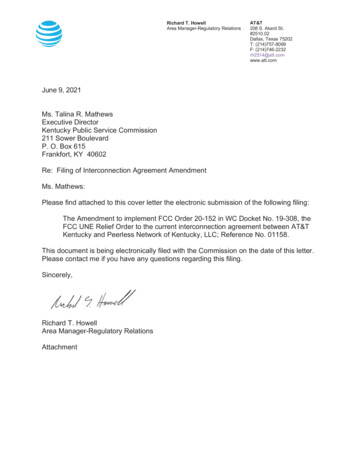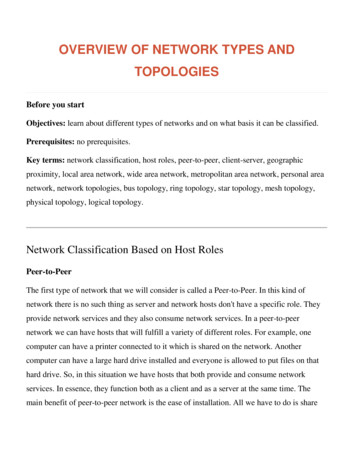
Transcription
OVERVIEW OF NETWORK TYPES ANDTOPOLOGIESBefore you startObjectives: learn about different types of networks and on what basis it can be classified.Prerequisites: no prerequisites.Key terms: network classification, host roles, peer-to-peer, client-server, geographicproximity, local area network, wide area network, metropolitan area network, personal areanetwork, network topologies, bus topology, ring topology, star topology, mesh topology,physical topology, logical topology.Network Classification Based on Host RolesPeer-to-PeerThe first type of network that we will consider is called a Peer-to-Peer. In this kind ofnetwork there is no such thing as server and network hosts don't have a specific role. Theyprovide network services and they also consume network services. In a peer-to-peernetwork we can have hosts that will fulfill a variety of different roles. For example, onecomputer can have a printer connected to it which is shared on the network. Anothercomputer can have a large hard drive installed and everyone is allowed to put files on thathard drive. So, in this situation we have hosts that both provide and consume networkservices. In essence, they function both as a client and as a server at the same time. Themain benefit of peer-to-peer network is the ease of installation. All we have to do is share
our resources on the network. It's also very inexpensive since we don't have to buy serverhardware and software. Of course, there's some drawbacks to a peer-to-peer network. Firstof all, a peer-to-peer network is not very scalable which means that the bigger it gets, theharder it is to manage it. That's because they lack centralized control. Peer-to-Peer networksare usually implemented in small organizations which use limited number of computers. Insituations where there are more than 10 computers on the network, we should considerusing centralized, server based network.Image 111.1 - Peer-to-Peer NetworkClient - ServerAnother classification within the host roles category is a client server network. In a clientserver network, unlike a peer-to-peer network, network hosts have specific roles assigned tothem. We have certain systems, certain hosts that are assigned to be servers. A serverprovides network resources. On a client-server network we also have clients orworkstations. Server provides the resources and the client uses resources. With a peer-to-
peer network everybody had the same or similar operating system, but in a client servernetwork client workstations have generic user-friendly operating systems like Windows XP,Vista, 7, MacOS or Linux. Servers would have some special optimized operating systemlike Server 2003 or Server 2008. These operating systems are designed to provide networkresources and are not designed for client type tasks. The main benefit of this type ofnetwork is that it's very highly scalable. That means it's very easy to expand the size of thenetwork, it's very easy to add more clients and it's very easy to add more servers. Clientserver networks are also much easier to support. That's because services are centralized. Ifwe know where are all the services, we know where to look when we have some problemswith them. Backup is also a lot easier. We can configure that users store their data on theserver. That way, instead of having to back up individual workstations we only need tobackup one location - the server. There are some drawbacks. Operating systems for serversare fairly expensive (the exception, of course, is Linux). The other thing is that this type ofnetwork takes a lot of planning. We have to decide which servers are going to host whichservices, where they're going to be placed on the network, etcetera.
Image 111.2 - Client-Server NetworkNetwork Classification Based on Geographic ProximityLocal Area Network (LAN)The first kind of network based on geography is the Local Area Network or LAN. Localarea network resides within a small geographic area. An example of a local area networkwould be the network inside a particular company or the network at our home. It can have,for example, multiple floors but they would all be connected by a network medium in someway. It could also be multiple buildings and they could be interconnected in some way. Wecould have several buildings, like a campus for example. It's still a local area networkbecause the network is managed by and belongs to single organization and the distanceseparating the hosts is relatively small. This is called an inter-network, but it is still a localarea network.
Image 111.3 - Local Area Network (LAN)Image 111.4 - Inter-connected LAN
Wide Area Network (WAN)It's also possible to have a computer network where the networks and the hosts are verywidely distributed geographically. In that case we are talking about a Wide Area Networkor WAN. A wide area network is a group of interconnected LANs, Local Area Networks,that are separated geographically. For example, a company can have offices at differentcities. Sometimes user from one city needs to access some data that is located on a server inanother city. To make that possible we've connected them in some way so that these localarea networks are inter-networked together, making a very large inter-network or a widearea network.Image 111.5 - Wide Area Network (WAN)Metropolitan Area Network (MAN)Metropolitan Area Network is spanning a physical area larger than a LAN but smaller thana WAN, such as a city. A MAN can be owned and operated by a single entity such as a
government body or large corporation, but it usually used by many individuals andorganizations. It is established by the various interconnections between WAN and LAN.MAN has many applications, it is most commonly used in banks, online reservationsystems and in many military based services. MAN can provide Internet connectivity orcable television for LANs in a metropolitan region.Personal Area Network (PAN)PAN is a computer network organized around an individual person. It is used forcommunication among computer devices, including telephones and personal digitalassistants, in proximity to an individual's body. Personal area networks typically involve amobile computer, a cell phone and/or a handheld computing device such as a PDA or Pad.PANs can be used for communication among the personal devices themselves(intrapersonal communication), or for connecting to a higher level network and the Internet(an up-link). PANs can be constructed with cables or wirelessly. USB and FireWiretechnologies often link together a wired PAN while wireless PANs typically use Bluetooth,IrDA, Wireless USB, Z-Wave and ZigBee. Bluetooth PANs are also called piconets.Personal area networks generally cover a range of less than 10 meters (about 30 feet).Network Classification Based on Network TopologiesNetwork topology is the layout of the various interconnected elements on a computernetwork. Topology can be physical or logical. It is good to know about network topologiesbecause different types of networking standards may use one type of physical topology, butuse an entirely different logical topology. The physical topology refers to the way thecomputer network is physically wired. In the first example we have many hosts that areconnected to the network medium trough a wire. This is a bus topology.Bus Topology
Many of the networking standards that we're going to work with will use the bus topology,whether physically or logically. On a bus topology all data flows on a central wire.Image 111.6 - Bus Network TopologyEach and every host connected to that wire can communicate directly with any other hostconnected to the wire. Today we won't see a lot of networks that still use the physical bustopology anymore. However, we will find many networks that still operate logically as abus.Ring TopologyIn the ring network topology there is no central connecting medium. Instead we have pointto point connections between network hosts. Every host is connected to its two neighbours.Unlike the bus topology, with a ring topology a given workstation or a host can onlycommunicate directly with only two other hosts on the network. Data that is addressed tohosts other than neighbors will be passed on to the next connected host until it reaches therecipient host.
Image 111.7 - Ring Network TopologyIn this way, information can be passed to any host on the network. It may not be a directconnection because it may have to go from host to host to host before it eventually arrives atits destination. Today we won't see many ring topologies anymore.Star TopologyA star topology uses a central connecting device. All hosts on the network connect to thecentral connecting device with a network cable and that's the physical topology. However,because of different protocols it may actually operate like a Ring or a Bus topology. If onehost needs to send data to some other host, it will send the information to the centralconnecting device. The central connecting device then replicates the information andforwards it on to the appropriate host.
Image 111.8 - Star Network TopologyThe way in which a central connecting device works depends on the networking standardthat we are using. Some devices will copy that data and send it out to all hosts (Hub). Eachhost will then look at that information and check if it is addressed to it. If the packet is notaddressed to that particular host, it will drop the packet. This way only the right recipientwill read the information in the packet.Other networking tehnology will operate in a very different manner. The central device willremeber which host is connected to which port on a central device (Switch). Because thecentral device knows which host is connected to which port, it will send data directly to theright recipient of the packet.Mesh TopologyThe mesh networking topology means that every host is connected to every other host onthe network. Let's take a look at example with five hosts.
Image 111.9 - Full Mesh Network TopologyThis is also known as full mesh topology. Now, imagine that we have 10, or 50 hosts.Things would get pretty complicated really fast. Because of that, this topology is moretheoretical, but it can be implemented more easily in wireless networking.Mesh Topology in Wireless NetworksBecause we don't have to have a separate network interface card for every host that we haveto connect to one host and because there are no cables, mesh topology can be utilized inwireless networks. Each wireless transmitter can directly communicate with the wirelessreceiver on any other host in the network. So called ad-hoc wireless network isimplemented in this way. In ad-hoc network there is no central connecting point. Instead,every wireless host communicates directly with any other wireless host. Ad-hoc networksare not usually implemented because the amount of work to set it up, configure andmaintain it is not worth it if we have more than 4 or 5 hosts. Most wireless networks are
actually configured in a star topology where there's a central connecting point called theWireless Access Point, to which all the transmitters connect to.Physical versus Logical TopologyThe physical way the computer network is wired may not actually be the way the computernetwork works logically. The logical topology tells us how the traffic flows on our network.We may have a network that's wired in one way, but operate in a completely differentmanner. For example, in a Star topology all hosts connect to a central connecting point, andthat's the physical topology. However, because of different protocols, it may actuallyoperate like a ring or a bus topology. Most of the computer networks today use the physicalstar topology, but remember, all networks can operate on two levels. How it works logicallycould be very different.RememberIn a peer-to-peer network network hosts don't have a specific role. In a client servernetwork, unlike a peer-to-peer network, network hosts have specific roles assigned to them.Local area network resides within a small geographic area like the network inside aparticular company or the network at our home. Wide area network is a group ofinterconnected LANs that are separated geographically, for example the same company canhave offices at different cities which are connected using WAN. Metropolitan AreaNetwork is spanning a physical area larger than a LAN but smaller than a WAN. PAN is acomputer network used for communication among various computer devices, includingtelephones and personal digital assistants, in proximity to an individual's body. Networktopology is the layout of the various interconnected elements on a computer network. On abus topology all data flows on a central wire. In the ring network topology there is nocentral connecting medium. A star topology uses a central connecting device. The meshnetworking topology in theory means that every host is connected to every other host on the
network. Ad-hoc wireless network is implemented using Mesh topology. The physical waythe computer network is wired may not actually be the way the computer network workslogically.Source : 1-overview-ofnetwork-types-and-topologies
network, network topologies, bus topology, ring topology, star topology, mesh topology, physical topology, logical topology. Network Classification Based on Host Roles . communicate directly with only two other hosts on the network. Data that is addressed to hosts other than neighbors will be passed on to the next connected host until it .

